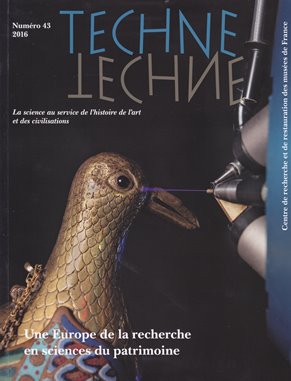 Éditorial
Éditorial
Michel Menu
Introduction
Jean-Louis Boutaine et Claire Pacheco
Répertoire des techniques d’examen et d’analyse des œuvres du patrimoine culturel citées dans ce numéro
I - Le développement des programmes européens : synthèse historique et critique
Jean-Louis Boutaine, Genèse des programmes européens LabS TECH et Eu-ARTECH
Michele Derrick, Jean-Louis Boutaine, The CAMEO Project : aims and results
Isabelle Pallot-Frossard, De Eu-ARTECH à CHARISMA : l’infrastructure de recherche élargit ses compétences et son champ d’action
Claire Pacheco, L’accès transnational FIXLAB : l’opportunité pour les scientifiues du patrimoine culturel d’accéder aux grands instruments
Bruno Brunetti, Costanza Miliani, Antonio Sgamellotti, MOLAB growth, aims and results
Joëlle Crétin, Clémence Raynaud, ARCHLAB : les archives au centre d’une nouvelle plateforme d’échanges scientifiques
Isabelle Pallot-Frossard, De CHARISMA à IPERION CH et E-RHIS : vers une infrastructure européenne de recherche pour les sciences du patrimoine
II - Le développement instrumental et méthodologique
Jean-Claude Dran, Thomas Calligaro, AGLAE au cœur du programme européen Eu-ARTECH
Zita Szikszai, Anikó Angyal, László Csedreki, Enikõ Furu, Róbert Huszánk, Zsófia Kertész, Zoltán Szoboszlai, Zsófia Török, Imre Uzonyi, Trans-National Access in the field of heritage science at the Laboratory of Ion Beam Applications, MTA Atomki
Claire Pacheco, Quentin Lemasson, Laurent Pichon, Brice Moignard, Marie Radepont, Didier Gourier, D’AGLEA à New AGLAE
Zsolt Kasztovszky, György Káli, Zoltán Kis, Imre Kovács, Adél Len, Boglárka Maróti, Katalin Pánczél-Bajnok, László Rosta, László Szentmiklósi, Zoltán Szõkefalvi-Nagy
, Applications of neutron-based and ion beam methods in Cultural Heritage research at the Budapest Neutron Centre
Loïc Bertrand, Sebastian Schoeder, Sophie David, Mathieu Thoury, Initiatives européennes d’IPANEMA et du synchrotron SOLEIL pour l’étude des matériaux anciens
Jacques Castaing, Michel Dubus, Alessandra Gianoncelli, Brice Moignard, Philippe Walter, Développement d’un appareil portable de diffraction et fluorescence des rayons X pour l’analyse non-destructive des œuvres d’art
III - Apport des accès transntionaux : études de cas
A. Contribution à la connaissance des œuvres
Iwona Szmelter, The impact of new data for identification and authorship : the case of The Last Judgement, triptych from the National Museum in Gdánsk, a Northern Renaissance work, by Rogier van der Weyden and Hans Memling
Marianne Mödlinger, Technological studies on Bronze Age metal body armour : from the Aegean to Western Europe
Andrew Meek, Anne Bouquillon, Patrice Lehuédé, Aurélia Masson, Alexandra Villing, Geneviève Pierrat-Bonnefois, Virginia Webb, Discerning differences : ion beam analysis of ancient faience from Naukratis and Rhodes
Lore Troalen, Claire Pacheco, Thomas Calligaro, Alison N. Hulme, Characterisation of metallic mordants in Subarctic Athapaskan quillwork : a PIXE-RBS study on replicate samples
B. Problématiques liées à la conservation-restauration
Muriel Vervat, An ARCHLAB project : researches on the painting technique of the three panels of the Battle of San Romano by Paolo Uccello
Laurianne Robinet, Céline Bonnot-Diconne, Claire Pacheco, Marie Radepont, Jean-Pierre Fournet, Mariabianca Paris, Marcella Ioele, Les cuirs dorés polychromes et le multi-accès FIXLAB CHARISMA : genèse d’une recherche innovante
Amandine C. Crabbé, Helena J. M. Wouters, Cristian Mocuta, Mathieu Silly, Loïc Bertrand, Herman Terryn ,Isabelle Vandendael, De Colorando Auro : researches on medieval colouring techniques using modern analytical techniques
